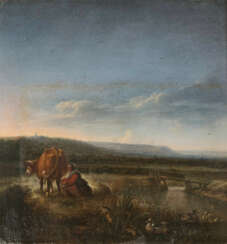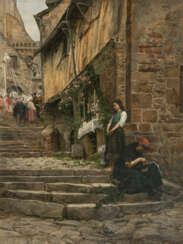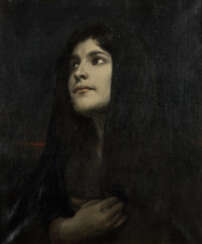
Painting of the 19th and 20th century — Alte Kunst, Moderne & Zeitgenössische Kunst

Alonso Cano was a multifaceted Spanish artist, renowned for his remarkable contributions in painting, sculpture, and architecture. Born in Granada in 1601, Cano is often celebrated as the "Spanish Michelangelo", a testament to his diverse artistic talents and significant impact on the Baroque era. His career, marked by a blend of Italian Mannerism and Baroque style, was a journey through various Spanish cities, each phase contributing uniquely to his artistic evolution.
In Seville, Cano trained under Francisco Pacheco, where his initial works like "San Francisco de Borja" (Seville Museum of Fine Arts) displayed a blend of Tenebrism and a brighter, more lyrical color palette. This period also saw the birth of works like "La Visión de San Juan" (Wallace Collection, London), signaling a transition in his style. Madrid, however, marked a significant turn in Cano's career. His works for the Buen Retiro Palace and the Alcázar showcase an evolution towards elegant, dynamic Baroque forms with lighter tonalities, influenced by the 16th-century Venetian masters.
Cano's return to Granada in 1652 was a homecoming that not only reinvigorated the Granada School but also marked his most prolific period. His masterpieces during this time include the series of paintings on the life of the Virgin in Granada Cathedral, a remarkable testament to Baroque art. Notably, his "Inmaculada Concepción" (1648) and "Nacimiento de la Virgen" (1663-1664) in the Cathedral stand as crowning achievements of his painterly career.
Equally impressive is Cano's sculptural work, where his polychrome wooden statue of the Immaculate Conception (1655) in Granada Cathedral is often hailed as his magnum opus. Despite sculpture being a secondary focus to his painting, his works, such as the Inmaculada in San Julián Church, Sevilla, and the smaller, yet exquisitely crafted, Inmaculada of the facistol in Granada Cathedral, resonate with the delicate beauty pointing towards Rococo art.
Cano's architectural prowess is exemplified in the design of Granada Cathedral's façade, an original piece of Spanish Baroque architecture. His artistic journey was not just a personal endeavor but a pivotal influence in the transition of Spanish painting towards a more idealist trend alongside Velázquez.
For art collectors and experts, Alonso Cano's works remain a cornerstone of the Baroque era, showcasing a blend of dramatic realism and spiritual depth. His influence extends beyond the boundaries of Granada, leaving an indelible mark on the world of art and culture.
To stay informed about new discoveries, product sales, and auction events related to Alonso Cano's works, sign up for our updates. This subscription focuses solely on providing relevant news in the art and antiques realm, especially concerning Cano's invaluable contributions.

Herman Saftleven the Younger was a Dutch artist of the Golden Age who was Dean of the Guild of St. Luke in Utrecht.
Herman Saftleven the Younger was born into a creative family. His father, Hermann Saftleven the Elder (c. 1580-1627), was the father of three artist sons, Hermann the Younger, Cornelis (1607-1681), and Abraham Saftleven (c. 1611/13 - 1646).
Saftleven the Younger was an extremely productive painter, draughtsman, and printmaker. He is known for his landscapes near rivers as well as scenes of people traveling in the woods.

Nicolaes Maes was a Dutch painter known for his genre scenes, portraits, religious compositions and the occasional still life. A pupil of Rembrandt in Amsterdam, he returned to work in his native city of Dordrecht for 20 years. In the latter part of his career he returned to Amsterdam where he became the leading portrait painter of his time. Maes contributed to the development of genre painting in the Netherlands and was the most prominent portrait painter working in Amsterdam in the final three decades of the 17th century.

Jules Louis Dupré was a French painter, one of the chief members of the Barbizon school of landscape painters. If Corot stands for the lyric and Rousseau for the epic aspect of the poetry of nature, Dupré is the exponent of its tragic and dramatic aspects.

Gabriel Cornelius Ritter von Max was a Prague-born Austrian painter.
Gabriel von Max was a significant artist to emerge from the Piloty School, because he abandoned the themes of the Grunderzeitliche (genre and history), in order to develop an allegorical-mystical pictorial language, which became typical of Secessionist Art.

Arthur Kampf was a German painter. He was associated with the Düsseldorf school of painting.
Kampf's work is most strongly associated with the genre of traditional history painting, though throughout his lifetime he explored styles influenced by Impressionism and Art Nouveau. He was also celebrated for large scale portrait work and in particular children's portraiture. Kampf also worked extensively as an illustrator, contributing drawings to volumes by Shakespeare (1925), R. Herzog, History of Prussia (1913) and J.W. Goethe, Faust (1925). Kampf's artwork post World War II largely focused on religious themes.

Max Clarenbach was a German painter of the first half of the twentieth century. He is known as a painter, landscape painter, genre painter and teacher and is considered one of the most important representatives of Rhenish painting of his time.
Max Clarenbach made study trips to Italy and Holland early in his career, where he formed his genre preferences and became a landscape painter. His work reflected the influence of the Hague School and the French Barbizonians. The artist skillfully depicted winter scenes and the nature of western Germany. He also painted sports and street scenes.
Clarenbach was one of the organizers of the Düsseldorf Sonderbund and taught at the Düsseldorf Academy of Art.

Max Clarenbach was a German painter of the first half of the twentieth century. He is known as a painter, landscape painter, genre painter and teacher and is considered one of the most important representatives of Rhenish painting of his time.
Max Clarenbach made study trips to Italy and Holland early in his career, where he formed his genre preferences and became a landscape painter. His work reflected the influence of the Hague School and the French Barbizonians. The artist skillfully depicted winter scenes and the nature of western Germany. He also painted sports and street scenes.
Clarenbach was one of the organizers of the Düsseldorf Sonderbund and taught at the Düsseldorf Academy of Art.

Eberhard Viegener was a German expressionist painter, decorator, and printmaker.
In the 1930s his expressionist works were deemed "degenerate," and during the Nazi "Degenerate Art" campaign a considerable number of them were removed from state collections and destroyed.
Later Figener shifted abruptly from the expressionist style to the style of New Objectivity, or Neue Sachlichkeit. He began to paint, in particular, architectural still lifes with ceramic objects.
Eberhard Figener was the brother of the painter and sculptor Fritz Figener.

Eberhard Viegener was a German expressionist painter, decorator, and printmaker.
In the 1930s his expressionist works were deemed "degenerate," and during the Nazi "Degenerate Art" campaign a considerable number of them were removed from state collections and destroyed.
Later Figener shifted abruptly from the expressionist style to the style of New Objectivity, or Neue Sachlichkeit. He began to paint, in particular, architectural still lifes with ceramic objects.
Eberhard Figener was the brother of the painter and sculptor Fritz Figener.





























































